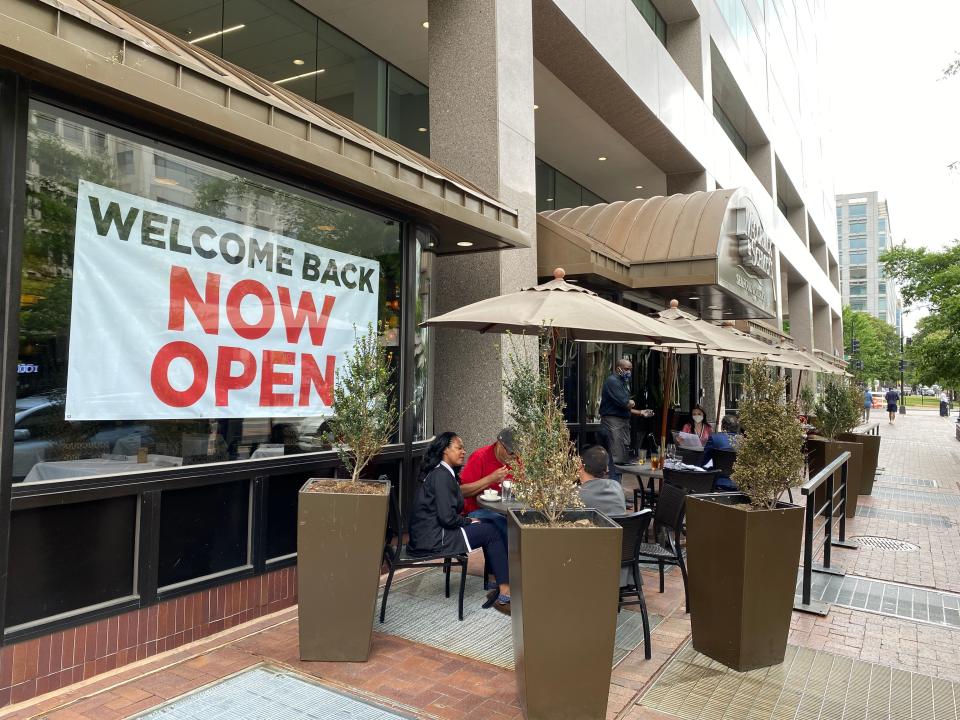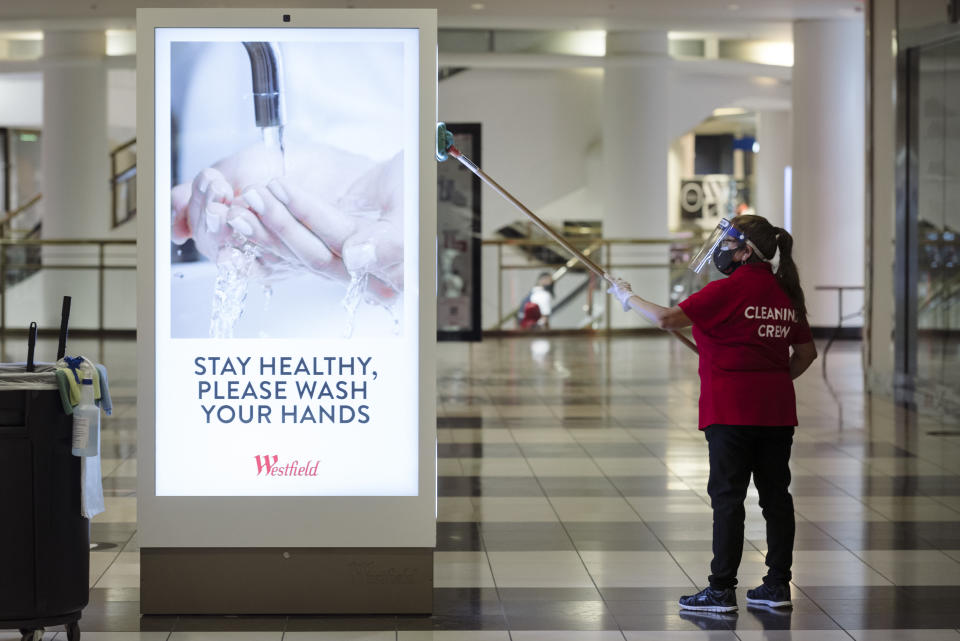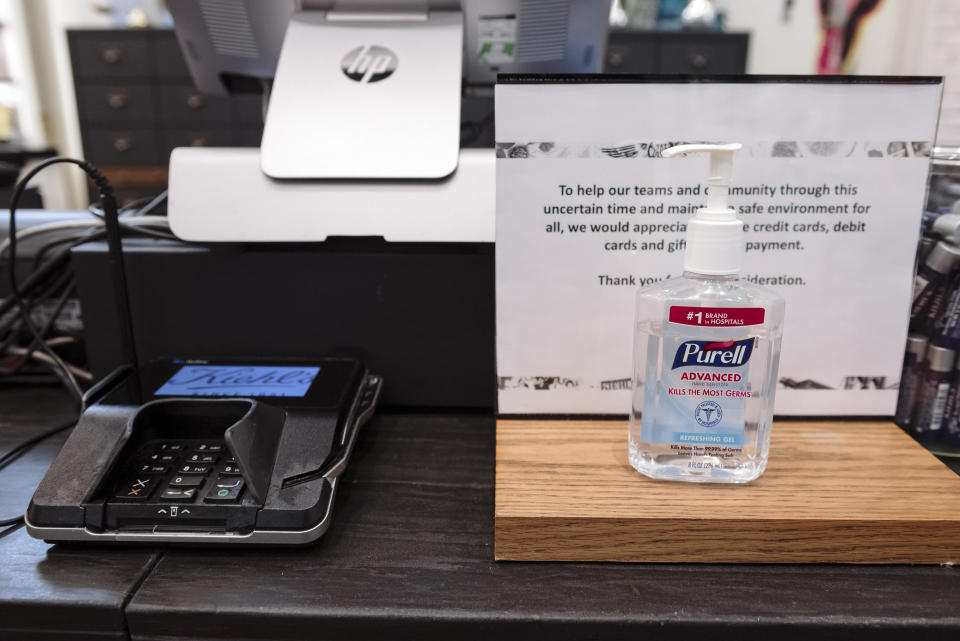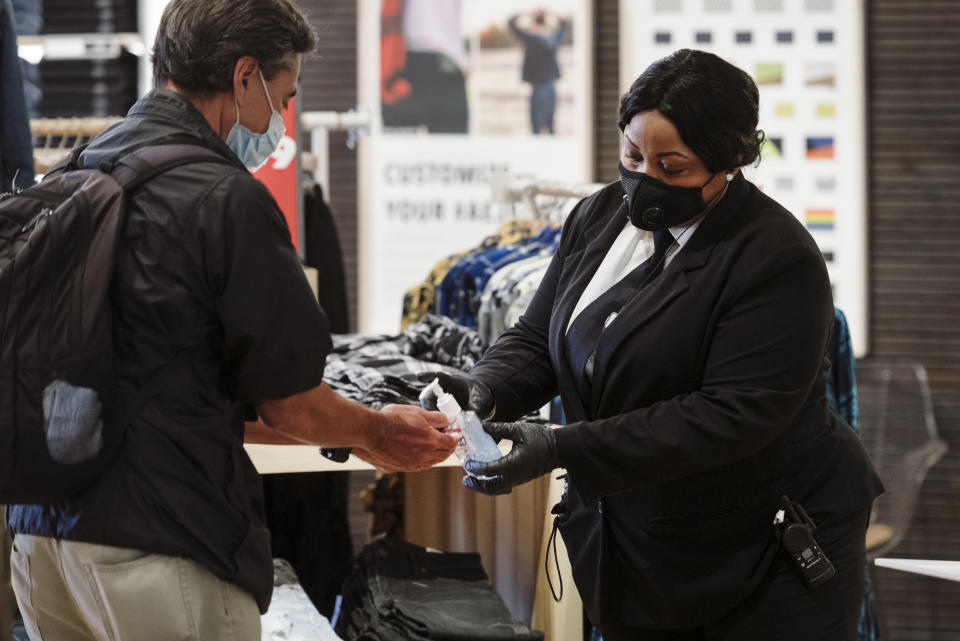As businesses reopen and shoppers return, coronavirus is rebounding, but government isn't tracking retail-based outbreaks
With states around the country reopening, shoppers are returning to malls and visiting stores again, prompting worried public health officials to point to rebounding cases of infections in some regions. Yet despite the continued risk of the coronavirus, there is no system in place for tracking whether these establishments have been involved in an outbreak, according to experts who follow worker safety and a survey done by Yahoo News.
While retail stores don’t call for the same number of people per room as COVID-19 incubators like meatpacking plants, they do demand many hours of work in a single building, often with limited ventilation, sharing of common spaces and bathrooms and copious public interaction. Yet the Occupational Safety and Health Administration (OSHA), the governmental body responsible for handling workplace-related injuries, including infectious diseases like COVID-19, has no system for keeping an up-to-date record of new cases.
“I think that the general consensus among unions is that OSHA has been a huge disappointment during this pandemic in protecting workers,” said Stuart Appelbaum, president of the Retail, Wholesale and Department Store Union.

He criticized OSHA for failing to issue citations related to COVID-19 since the pandemic began despite the multitude of worker deaths. (OSHA has issued a single citation since the start of the outbreak, though not for a retailer. Winder Nursing in Georgia was cited on May 18 for failure to report under the agency’s record-keeping requirements, according to a Department of Labor spokesperson.)
OSHA has come under criticism in the past for its failure to provide oversight, and critics say those problems have gotten worse under Secretary of Labor Eugene Scalia, who came into office under President Trump. Scalia has a history of voting against proposed worker assistance programs, and OSHA was criticized in May by AFL-CIO president Richard Trumka for being “missing in action” and “failing to meet their obligation and duty to protect workers.”
“Very little surprises me in the Trump era, but I am incredibly disappointed that OSHA has not had a more active role in protecting workers from the largest health and safety problem that our workforce has ever seen,” Appelbaum said.
The administration said it is currently investigating more than 5,000 COVID-19-related complaints and is trying to speed up the process. “OSHA is using the complaint investigation process to more rapidly address COVID-19 complaints,” a Labor Department spokesperson told Yahoo News. “OSHA’s goal is to expeditiously remove workers from hazards, or eliminate hazards within the workplace.”
Yet it’s not just OSHA that is failing to shed light on possible outbreaks. Yahoo News surveyed the top 20 U.S. retailers about their policies for informing employees — and the public — about coronavirus cases among employees at their facilities. Only five responded, and of those, only three companies — Amazon, Target and Home Depot — explicitly told Yahoo News that employees are informed if there’s a known case in one of their facilities or stores.
None of those companies, including the three that said they informed employees, would say whether they made any effort to disclose the infections publicly, potentially leaving customers in the dark.

“We’re informing team members who work at a location where a case of the coronavirus is confirmed, and we’ll continue to be transparent in the process,” said Jake Anderson, head of communications at Target. “While being transparent, we’re also careful to keep team member privacy from being compromised with the information we share. There are some details we do not provide, as it increases the likelihood of a team member’s privacy being compromised.”
Amazon operates only a very small number of retail stores, but its warehouses have become a crucial backbone for distribution of consumer products during the pandemic, and there have been a number of outbreaks at its warehouses. The company says it is informing employees at facilities where there has been an infection reported.
“When a COVID-19 case is confirmed in one of our buildings, we communicate this news to all individuals who work at that site — not just to those who’ve come in close contact with the diagnosed individual,” Amazon spokeswoman Deborah Bass told Yahoo News.
TJX, the parent company of T.J. Maxx, Marshalls and HomeGoods, did not respond to whether it informs employees about coronavirus cases in its stores, but it said it has established a process to support the health and wellness of its associates and customers and that it is cooperating with local health department guidelines.
Dollar General responded with a link to the company’s media site, which did not provide information about any recording or reporting of COVID-19 cases.
How much of a threat the coronavirus poses to employees, or customers, at retail establishments is hard to say. Since reopening, numerous states have required stores to limit the number of customers allowed inside and mandated the use of face masks for both staff and customers.
What little data is available suggests there is a risk. In Colorado, for example, health care, food processing plants and correctional facilities still represent the largest share of COVID-19 cases, but retail establishments account for the majority of new outbreaks, according to data from the Colorado Department of Public Health and Environment. Even in stores that implemented strict social distancing measures, limited the number of people inside and required employees to wear masks, outbreaks still occurred.
Yet a lack of data collection makes it difficult to assess the risks for retailers.

Many employers are working to trace the virus to every potentially infected individual by asking the original infected person which department they work in, who they have come into contact with and where they have gone in the last several days. But OSHA does not have a system to record COVID-19 cases in real time, which means there is no way to get an idea of how much the virus is spreading through retail facilities — or if the safety precautions outlined by the CDC are working.
OSHA does require employers to record injuries and fatalities in the workplace, and those logs are also available to unions and workers and are intended to be made public on OSHA’s website. But the logs don’t provide real-time data collection because they are typically annual reports.
In response to questions from Yahoo News, OSHA highlighted its responsibility to judge whether employers have been negligent in their investigations of a COVID-19 case, but it said nothing about recording active cases despite being asked about that specifically.
“OSHA’s guidance emphasizes that employers must make reasonable efforts, based on the evidence available to the employer, to ascertain whether a particular case of coronavirus is work-related,” a Labor Department spokesperson told Yahoo News. “Recording a coronavirus illness does not mean that the employer has violated any OSHA standard.”
The spokesperson added that employers with 10 or fewer employees have no recording obligations other than those that result in a fatality, or an employee’s inpatient hospitalization, amputation or loss of an eye.
One of the primary difficulties in tracking cases is that it is nearly impossible to determine if someone contracted COVID-19 from work — and only work-related cases are required to be recorded by OSHA.
“Given the nature of the disease and community spread, however, in many instances it remains difficult to determine whether a coronavirus illness is work-related, especially when an employee has experienced potential exposure both in and out of the workplace,” the Labor Department spokesperson said.
OSHA has not developed a plan to exempt the virus from work-related requirements.

On April 10, soon after the virus first hit, OSHA put out interim guidance saying that most employers outside the health care industry didn’t need to record COVID-19 cases due to the difficulty of making a determination about whether a worker had contracted the virus at work.
“OSHA realized that for non-high-risk employers, it was going to be difficult to figure out if this was work-related. We still don’t know how it travels,” said Steve Parascandola, an OSHA and environment lawyer at Smith Anderson. “So they recognized to the public that this is difficult to do and wanted people to focus on PPE instead.”
But on May 26, as cities began to reopen, OSHA rescinded the memorandum and enforced a new one that is intended to specifically address COVID-19. This new guidance requires employers to carry out a full investigation into whether the virus qualified as work-related. Employers must ask how the employee contracted it, inquire about out-of-work activities and review the employee’s work environment.
These requirements encourage more effort to be put into investigating outbreaks, but they still limit recording to illnesses that were acquired at work.
“Work-related determinations are fairly obvious in most situations, but causation for coronavirus, even beyond OSHA, is going to be an extremely difficult thing to prove, at least in the short term,” said Parascandola.
Worker safety seems to be getting lost in OSHA’s efforts to make regulations that are easy for employers to follow. But because COVID-19 spreads more rapidly indoors and people are most at risk when they are in close proximity for several hours, experts feel OSHA should be requiring more vigilance from retail employers.
“I think we don’t have enough information. We need more information,” said Appelbaum, the union president. “We need to know how well different employers are keeping the public safe, and I think just the fact of having a database would make employers much more careful.”
In the absence of that sort of database, it’s up to employers to inform employees of infection, and bolstered privacy protections prevent them from sharing the name of the infected person, making it more difficult for co-workers to know if they have had contact.
“I can’t stress enough, privacy laws have greatly expanded to the point where now they are maybe butting up against these efforts,” said Parascandola.
In general, the emphasis has not been on recording cases but rather on taking safety precautions to avoid them.
“Now that states have reopened, cities and counties are issuing directives of what’s needed: counseling nonessential employers, helping them to move from a shuttered business to opening that business safely,” said Chuck Keller, a lawyer at Snell & Wilmer. “I wouldn’t say recording is necessarily part of the plan itself.”
Karin Jones, a partner at the law firm Stoel Rives, says the employers she’s worked with have been eager to identify and disclose sick employees. However, without data of who is contracting the virus, there is no way to know if the recommended standards are working.
“The travesty is that you can’t really evaluate whether the protections being employed are adequate or not,” said Jonathan Rosen, an expert in industrial health and workplace safety and a consultant to the government and labor unions. “There are big debates about cloth masks, surgical masks, N95 respirators, sneeze guards and plexiglass.”

Unions are also playing a role in advocating for workers. The Retail, Wholesale and Department Store Union is insisting that stores inform it if one of their employees gets sick, according to Appelbaum, who says over 42 people among its members have died.
The union has successfully made demands at stores like Macy’s to require that temperature checks be carried out by the store rather than having employees check their own temperature at home as initially requested. It has also reached an agreement that union members are not required to serve customers who are not wearing a mask.
“I think OSHA needs to be aggressive in ensuring workplace safety is adequate,” Appelbaum said. “I have heard over and over again that people have stopped contacting OSHA because it’s a waste of time. That needs to change.”
Rosen says that ultimately, OSHA is failing to perform its core oversight functions.
“The whole concept of OSHA is to have uniform, national, federal-level standards for the whole industry so that we don’t have 51 different standards,” said Rosen.
“That’s the whole failing,” he said. “OSHA isn’t doing its job.”
_____
Read more from Yahoo News:


